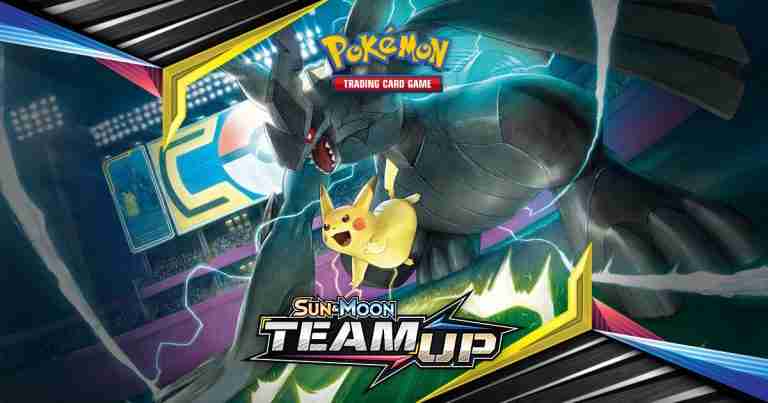Rotation Guide 2020 Part 2: Forbidden Light
Welcome back to part 2 of my complete guide to this years rotation. Today we’re looking at Forbidden Light, a set that still sees many of its cards played in Standard. In particular, the set was renowned for two things: Ultra Beast cards, and Squids… Let’s take a look!
Pheromosa

An interesting tech card, Pheromosa saw play in a variety of decks but was most popular in Baby Blowns due to the fact that both cards could make use of Beast Energy. Being able to do 50 damage for 1 energy was great early game pressure and could make all the different in the late game to ensure that Blacephalon was able to hit the right numbers to ensure a knockout on a TagTeam Pokémon.
Palkia GX

Although Palkia GX was never the most prominent card in any format, Zero Vanish GX posed a phenomenal threat and had the capability to completely swing the momentum of any match into your favour. However, the expensive attack cost meant that there was always a risk of relying on Palkia GX in certain matchups or to get you out of a difficult spot. Whilst it began seeing a lot more with release of Frosmoth variants, the increased play of Crushing Hammers (which looks to continue in Darkness Ablaze) may well have seen an end to Palkia GX either way.
Greninja GX

An interesting GX card, Greninja was played in a variety of decks which utilised either its ability or one of its two attacks. First of all, it was played as a one of Greninja BREAK decks, with Suriken Flurry combining well with Splash Energy to spread even more damage counters around the board. Next, Greninja Meganium Swampert was able to take advantage of instant evolutions to shuffle damaged Greninja’s into the deck with Haze Slash. Finally, when Water Mewtwo made a brief spash (pun not intended) at Worlds last year, Greninga GX offered a nice sniping options for finishing off damaged bench GX Pokémon.
Volcanion Prism Star

You have to feel a bit sorry for Volcanion. A card this strong deserved to be in a high tier archetype, but the truth is that there were never any water decks strong enough to mount a challenge. Having built in gust was always handy for getting a tricky opposition Pokémon out of the active, whilst being able to spread up to 200 damage around the board always made Volcanion worth including in any water deck.
Malamar

And here we are. For every player that loved Malamar for its amazing psychic acceleration, there was another who hated it for its long spell as gatekeeper for all other one-prize decks. Its partnership with Giratina was a deadly cycle, meaning that you could instantly respond to a KO. If it used psychic energy, it was, at one point or another, played with Malamar. Ultra Necrozma GX, Mewtwo & Mew GX and even Dragapult VMAX all took advantage of the squids who, without them will now either disappear entirely, or adapt to function with new engines.
Naganadel GX

Speaking of Mewtwo & Mew GX, Naganadel GX was a key component of both the Malamar and Welder variants. Whilst it saw play in Blacephalon GX archetypes to provide another option for your gameplay, Naganadel was used in Mewtwo decks to ‘checkmate’ an opponent who was only a few prizes away from victory. Stinger GX’s ability to reset prize cards to 3 each meant that only one knockout on a TagTeam Pokémon was required for victory. Also, it came very much handy against control decks, giving an opponent a lot less time to set up and win the game.
Zygarde GX

With all the fighting support that was released late on in XY and early on in SUM, Zygarde GX provided another neat option for various different archetypes. Starting off as the main attacker of the deck, Zygarde peaked with a 3rd place finish at Worlds 2018. Afterwards, it provided more of a backup option to both Buzzwole GX and Lycanroc GX, being able to accelerate 2 fighting energy for just a DCE whilst also being able to buy a turn with Verdict GX came in handy. Oh yeah, and it also paired quite nicely with a certain Supporter card.
Diancie Prism Star

Speaking of fighting support, Diancie Prism Star is a big loss going as Eternatus VMAX looms on the horizon. Played in pretty much every fighting deck, Diancie was vital in filling the void left by Strong Energy in ensuring that you hit the right numbers needed for a KO.
Buzzwole

Buzzwole was played for one reason, the Sledgehammer turn. Being able to do 120 damage out of nowhere for just a single energy meant that Buzzwole was a great option for any deck that played either fighting or Ultra Beast Pokémon. Of its many partners, its three favourites decks were Buzzwole GX, Zapbeats and Spiritomb Beasts. The versatility Beast/Rainbow energy (as well as being able to OHKO PikaRom), made Buzzwole a great option for toolbox decks.
Yveltal GX

A card that saw almost no play for almost 2 years, Yveltal GX finally had its chance to shine with the release of Galarian Zigzagoon and Obstagoon from Sword and Shield. Being able to drop damage counters wherever you pleased made Doom Count GX a much more achievable option. Even in the last few weeks Yveltal GX has managed to find itself in another deck, becoming one of the core components of Henry Brand’s Galaxy Mewtwo.
Dialga GX

As tempting as Timeless GX always appeared to be, the truth was its energy requirement was simply far too expensive. Also, with a retreat cost of 3, you had to have another attacker ready to power up as well as a switch out, less you hit for a measly 80 damage. If you wanted to buy yourself some time, there were simply far cheaper and far better options available.
Florges

A different kind of stall deck, Florges ability to bring back any item card meant that instead of healing a bulky basic Pokémon, it would bring back Lillie’s Poké Doll time and time again to prevent you opponent from ever taking a prize. Well, that was the plan at least, one that had two potential pitfalls. First of all, Florges is a stage 2, meaning that if you didn’t set one up in your opening turns, your opponent could run through your board. Secondly, you had to flip a coin to see if you could recover an item card. When it worked, it really worked, but it was all for nothing if luck wasn’t on your side.
Xerneas GX

A popular option for Gardeon (remember that deck?), Xerneas GX provided healing support through Sanctuary GX which could take advantage of the decks ability to have multiple Gardeon’s in play that were damaged, moving all of it over to over to the opponents active to score a big OHKO. Since the rise of Zacian V, Xerneas GX has only appeared in the aforemention Galaxy Mewtwo, again for the powerful effect that Sanctury GX provided.
Goomy

Played in a variety of stall decks throughout its life, Goomy most recently saw play in Cincinno mill. Decks in which Goomy thrived the most were ones where you denied your opponent the opportunity to attack, in Cincinno’s case through a combination of energy denial and milling of resources. Goomy added a nice option to ensure that opponents were unable to score a KO.
Ultra Necrozma GX

Ultra Necrozma GX was paired up with Malamar as soon as it was revealed, marking the difference between the Giratina and ‘Ultra’ varients of the archetype. The rate at which Photon Geyser’s damage scaled was deadly, being able to OHKO GX Pokémon without the restriction of a damage cap. Upon the release of Mewtwo & Mew GX, Ultra Necrozma GX again benefitted from Malamar in a more versatile toolbox deck. In addition, Sky-Scorching Light also provided the ability to take devastated multiple KO’s to take multiple prizes.
Arceus Prism Star

Given that it is the literal creator of all Pokémon, you’d think that Arceus would get better cards. Well, sadly, its Prism Star continued the trend of being rather rubbish, with most decks not having enough space to accommodate so many types More recently, it saw some experimentation with Lapras VMAX, combining it with Dedenne GX and Eldegoss V.
Beast Ring

Although it took until the fourth set of the SUM block to get the first Ultra Beast cards, The Pokémon Company certainly didn’t hold back in giving them support. Beast Ring offered the best kind of energy acceleration, from the deck, to an Ultra Beast of your choosing. If you gave a TagTeam or VMAX Pokémon that kind of support, it would almost certainly push any other kind of deck completely out the format. The beneficiaries of this card, unsurprisingly, were those who had expensive attack costs, such as Buzzwole GX, Blacephalon GX and Baby Blacephalon.
Bonnie

The aforementioned ‘Zygarde GX’ Supporter, this card saw very little play in comparison. Being a Supporter that didn’t progress your own board space, in addition to providing an effect that could be gusted around, it’s not hard to see why.
Crasher Wake

Stuck in a similar situation to Bonnie, Crasher Wake just wasn’t strong enough to make it worth including. Although it synergised well with Aqua Patch, the option to draw 5-7 cards from the large pool of draw Supporters was simply a much better option. It was rare to have enough energy in hand to discard without missing your attachment for the turn.
Diantha

Although Diantha only really saw play in one deck, Granbull, it was almost the ideal supporter. With its low HP, the most common targets for Diantha were often Granbull and an energy, in order to supply a quick reload of attackers for the turn. Thanks to a brief revival in the Limitless Qualifiers, Granbull will also seemingly hold the mantle of being the last surviving Fairy deck. Rest in peace.
Eneporter

Energy disruption was never the right word to use when describing Eneporter. It was more… energy inconvenience. Although you could were guaranteed to move an energy from a potential opposing threat, the far superior (if risky) effect of Crushing and Enhanced Hammer could win games on their own.
Fossil Excavation Map

A card that was only ever as good as the fossil Pokémon it could evolve into, Fossil Excavation Map was inferior to Pokémon Research Lab in every way. It could search and evolutions, and it could search out twice as many cards. It just goes to show how underwhelming the fossil mechanic is when the preferable set up option prevents you from attacking
Judge

The hand control of choice for Zoroark GX, it allowed you to force your opponent into a smaller hand size while you drew back into a larger hand size with trade. However, with Zoroark gone and with Reset Stamp and Marnie being played in almost every deck, Judge has fallen completely off the map.
Lady

Whilst 4 energy may have seemed like an amount high enough to make Lady viable, the amount of ‘rain dance’ decks that existed during its lifetime were few and far between. Of the two the saw the most (if fringe) play, metal Magnezone had Mt. Coronet which could recycle energy continuously, and Frosmoth has Capacious Bucket which could do half the job in item form, meaning that both decks had the ability to choose much better Supporters.
Lysandre Prism Star

An interesting card, but one that could never quite synergise the way it was intended. Whilst sending your opponent’s cards to the Lost Zone was never a bad thing, the fact that you could only choose cards that had already been discarded often led to getting rid of resources that had already been used. In the early game, you either didn’t have enough fire Pokémon in play or your opponent didn’t have enough cards in the discard pile. Meanwhile, in the late game, most of their main resources had either been used, or were sat on their board.
Lysandre Labs

Lysandre Labs was a great option for many different decks, as it turned off tools that would otherwise make certain matchups very difficult to win. Fairy Charms, for example, were a mainstay in Gardeon for allowing it completely shutting the door on Pikarom. More recently, Lysandre Labs became a key card in the ADPZ mirror, as it allowed Zacian V to OHKO an ADP (with a Galarian Zigzagoon) even if it had a Big Charm on. However, with Tool Scrapper being reprinted in Rebel Clash, you could now shut down your opponent’s tools whilst still being able to play your own.
Metal Frying Pan

Speaking of APDZ, this is another card that Zacian V will definitely miss. With Baby Blowns seeming sticking around for the foreseeable future, and with Centiskorch VMAX releasing in Darkness Ablaze, Zacian will definitely be more scared of fire decks going forward. Also, the rotation of Metal Frying Pan also means that LucMetal no longer has the ability to sit being a -60 wall for the rest of the game after using its GX attack.
Mysterious Treasure

While the loss of Mysterious Treasure will not hit as hard thanks to the recent releases of Quick Ball and Evolution Incense, the ability to choose between a basic and a stage 1 will undoubtably make Psychic (and I guess Dragon?) decks less consistent. You only need to look at the three decks that played Mysterious Treasure the most, Malamar, Psychic Mewtwo and Dragapult VMAX, to see that this card would instantly improve the consistency of any evolution deck in the format, regardless of the type it applied to.
Ultra Space

Ultra Space most benefitted two types of Ultra Beast decks, those that played very few Pokémon, and those that played evolutions. As it so happened, the two decks in which Ultra Space was almost entirely played required just that. Baby Blacephalon loved the ability to instantly search out another attacker to ensure an instant reload of attackers, while Blacephalon GX needed Poipoles down early so that they could evolve into Naganadel’s on turn 2.
Beast Energy Prism Star

Boy, they really didn’t hold back with the Ultra Beast support, did they? If your deck had any Ultra Beasts in it, well, there was a decent chance that it also had a Beast Energy. At first, it mainly saw play with Buzzwole GX (which also had access to Strong Energy and Diancie Prism!) and Baby Buzzwole, before moving over to the Blown twins. It was especially helpful to them, as it allowed them to hit those Pokémon GX whose HP didn’t end in a 5 or a 0, saving themselves an extra fire energy.
Unit Energy FDY

The last of the three Unit Energy cards, FDY was probably the least played of the 3 in the latter stages their legality. However, before last years rotation, FDY saw huge amounts of play in Zoroark Lycanroc and Buzzwole Garbodor, where it synergised with each decks most important Pokémon (and Tapu Lele GX) brilliantly. I very much hope we see a similarly designed set of cards released in the SWSH block, due to the creativity that these kind of cards can spawn.
Energy Recycler

Saved by this secret rare reprint, Energy Recycler seemed to be played with a particular type of stage 2 card. Both Vikavolt, and, more recently, Rillaboom loved to get lots of energy into play quickly, with there being no faster way of doing so than from the deck itself. When its bulky attackers (Tapu Bulu GX, Rayquaza GX, EggRow) were knockout out, Energy Recycler allowed you to put all the discarded energy back into the deck ready to go again. Sadly, thanks to the way the meta has shaped, it looks like Rillaboom will probably never have the same impact that Vikavolt had. #MakeStage2sGreatAgain






